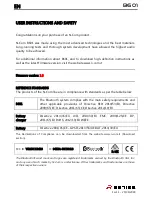
31
CAUTION
Never leave the key in the latch. If the steering is turned to the left with the
key inerted in the latch it will be severely damaged.
STEERING PLATE
Fitting and adjusting the steering plate (versions with steering tilt ad-
justment only)
Fitting the Steering plate.
Follow the procedure set out below to
fi
t the steering plate:
A) Fit the dust guard and the bearing onto the PLATE using a press and mak-
ing sure you lay a reinforcement round beneath the pre-
fi
tted sleeve.
CAUTION: do not lean on the clamp underneath the plate.
B) Fit the lower plate onto the motorbike, installing the bearing, the upper
dust guard, the respective ring nut and adjusting any play and the sti
ff
-
ness of the steering unit.
C) Now
fi
t the upper plate making sure you leave the four carriage bolts and
the front and rear grub screws loose.
D) Fit the nut onto the rear plate, insert the forks, adjust to the required
height and begin to tighten the screws according to the sequence and
tightening torques speci
fi
ed below:
1) lower plate socket head screws (18 Nm)
2) the nut on the upper plate (20 Nm)
3) the carriage bolts (10 Nm)
4) upper plate socket head screws (12 Nm)
5 and 6) the two grub screws (18 Nm)
1
5
1
4
3
3
6
4
2
Adjusting the Steering plate.
In order to make the desired adjustments, loosen only the 4 screws (3) with
an 8 mm hexagon head on the carriage, and
fi
t it back into place with the two
grub screws (5 and 6) ; you do not need to loosen the nut on the sleeve.
When the reference line of the carriage coincides with the long mid-line of the
milled ruler on the plate, the motorbike adjustment setup is standard. You can
see each adjustment thanks to the notches.
The plate can translate up to a maximum range of 3 degrees, which is tanta-
mount to a movement of approximately 3 cm on the front wheel compared to
the motorbike standard setup, which can thus become progressively longer
by about 1.5 cm, or shorter by about 1.5 cm.
For a more responsive motorbike, that enters and travels through bends more
quickly, proceed as follows:
a) loosen the four carriage screws (3)
b) loosen the grub screw situated at the rear (5) of the plate and move for-
ward with the grub screw situated at the front (6) of the plate until you
reach the desired adjustment
c) tighten the 4 hexagon head screws (3) on the carriage
d) tighten the two grub screws (5 and 6) against one another fully (make
sure they are fully up against the carriage)
N.B. if this adjustment is accentuated too much, this may result in insta-
bility problems at high speed on straight routes; some trial and error is
therefore required to
fi
nd the best compromise.
For a more stable motorbike at high speed and on very quick bends, proceed
as follows:
a) loosen the 4 carriage screws
b) loosen the grub screw situated at the front (6) of the plate and move for-
ward with the grub screw situated at the rear (5) of the plate until you
reach the desired adjustment
c) tighten the 4 hexagon head screws (3) on the carriage
d) tighten the two grub screws (5 and 6) against one another fully (make
sure they are fully up against the carriage)
Summary of Contents for TZ 125 2011
Page 1: ......
Page 64: ...64 WIRING DIAGRAM 125cc...
Page 65: ...65 WIRING DIAGRAM 200cc 250cc 300cc electric starter...
Page 71: ...71...
Page 72: ...CODE CATALOGUE 02645005...
















































